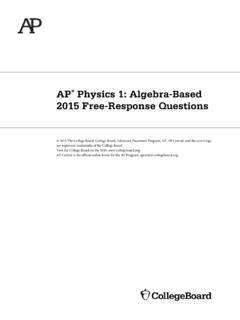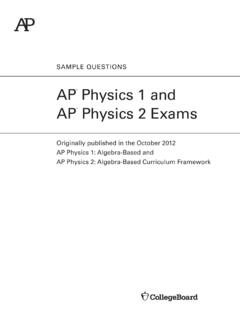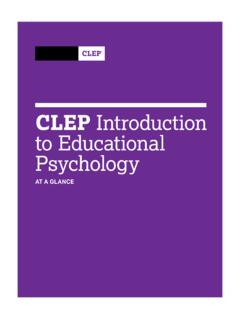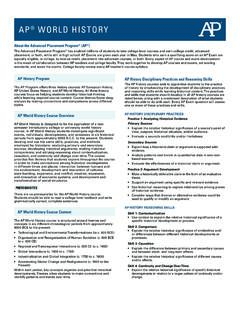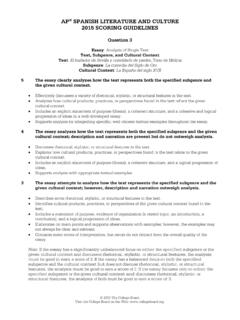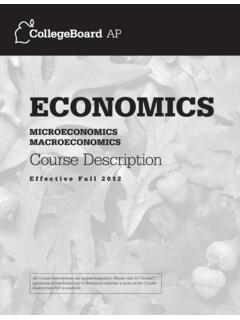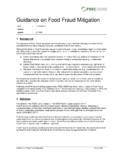Transcription of AP Chemistry Course and Exam Description - College Board
1 AP Chemistry .. Course and Exam Description Revised edition Effective Fall 2014 . AP Chemistry .. Course and Exam Description Revised Edition Effective Fall 2014 . The College Board New York, NY. About the College Board The College Board is a mission-driven not-for-profit organization that connects students to College success and opportunity. Founded in 1900, the College Board was created to expand access to higher education. Today, the membership association is made up of over 6,000 of the world's leading educational institutions and is dedicated to promoting excellence and equity in education. Each year, the College Board helps more than seven million students prepare for a successful transition to College through programs and services in College readiness and College success including the SAT and the Advanced Placement Program.
2 The organization also serves the education community through research and advocacy on behalf of students, educators and schools. For further information, visit AP Equity and Access Policy The College Board strongly encourages educators to make equitable access a guiding principle for their AP programs by giving all willing and academically prepared students the opportunity to participate in AP. We encourage the elimination of barriers that restrict access to AP for students from ethnic, racial and socioeconomic groups that have been traditionally underserved. Schools should make every effort to ensure their AP. classes reflect the diversity of their student population. The College Board also believes that all students should have access to academically challenging Course work before they enroll in AP classes, which can prepare them for AP success.
3 It is only through a commitment to equitable preparation and access that true equity and excellence can be achieved. This edition includes updated exam information and minor revisions to Appendix A. See About This Edition on page v for details. Third reprint. 2014 The College Board . College Board , Advanced Placement Program, AP, AP Central and the acorn logo are registered trademarks of the College Board . All other products and services may be trademarks of their respective owners. Visit the College Board on the Web: ii Contents About This v About AP .. 1. About the AP Chemistry Course and 2. How AP Courses and Exams Are 2. How AP Exams Are 3. Using and Interpreting AP 4. Additional 4. AP Chemistry Curriculum 5. 5. The Emphasis on Science 5.
4 Overview of the Concept 6. The Concept 8. Big Idea 1: The chemical elements are fundamental building materials of matter, and all matter can be understood in terms of arrangements of atoms. These atoms retain their identity in chemical 8. Big Idea 2: Chemical and physical properties of materials can be explained by the structure and the arrangement of atoms, ions, or molecules and the forces between them.. 19. Big Idea 3: Changes in matter involve the rearrangement and/or reorganization of atoms and/or the transfer of Big Idea 4: Rates of chemical reactions are determined by details of the molecular collisions..46. Big Idea 5: The laws of thermodynamics describe the essential role of energy and explain and predict the direction of changes in Big Idea 6: Any bond or intermolecular attraction that can be formed can be broken.
5 These two processes are in a dynamic competition, sensitive to initial conditions and external perturbations..68. Science Practices for AP Appendix: AP Chemistry Concepts at a The Laboratory Investigations .. 107. Inquiry Instruction in the AP Science Time and Recommended 2014 The College Board . iii Participating in the AP Course 111. Curricular Requirements .. 111. Resource 112. Exam 113. How the Curriculum Framework Is 116. Sample Multiple-Choice 117. Answers to Multiple-Choice 135. Sample Free-Response Scoring Guidelines .. 142. Appendix A: Preparing Students for Success in AP Chemistry .. 150. Appendix B: AP Chemistry Equations and 161. Appendix C: How to Set Up a Lab 2014 The College Board . iv About This Edition About This Edition This edition of the AP Chemistry Course and Exam Description includes the following changes, which take effect in fall 2014 : The Exam Information section has been edited to reflect the addition of 15 minutes to the free-response section of the exam.
6 Starting with the May 2015. exam administration, the exam will be 3 hours and 15 minutes long and include both a 90-minute multiple-choice section and a 105-minute free-response section. The descriptions of desired performance in Appendix A have been minimally revised for clarity and ease of use. This edition also reflects changes to the curriculum framework that were made in previous editions, as described in Table 1 and Table 2 below. Table 1. Spring 2014 Revisions Fall 2013 Curriculum Framework Spring 2014 revisions Essential Knowledge 1. Substitutional alloys form between 1. Substitutional alloys form between atoms of comparable radius, where one atoms of comparable radius, where one atom substitutes for the other in the atom substitutes for the other in the lattice.
7 (Brass is an example in which lattice. (Brass is an example in which some copper atoms are substituted some copper atoms are substituted with a different element, usually zinc.) with a different element, usually zinc.). The density typically lies between The density typically lies between those of the component metals and the those of the component metals, as with alloy remains malleable and ductile. interstitial alloys, substitutional alloys 2. Alloys typically retain a sea of mobile are less malleable and ductile than pure electrons and so remain conducting metals. 3. In some cases, alloy formation alters 2. Alloys typically retain a sea of mobile the Chemistry of the surface. An electrons and so remain conducting example is formation of a chemically 3.
8 Often the surface of a metal or alloy is inert oxide layer in stainless steel. changed through a chemical reaction. An example is formation of a chemically inert oxide layer in stainless steel, through reaction with oxygen in the air. Essential Knowledge Covalent network solids generally have Covalent network solids have properties extremely high melting points and are hard that reflect their underlying 2-D or 3-D. and are thermal insulators. Some conduct networks of covalent bonds. Covalent electricity. network solids generally have extremely high melting points and are hard. Return to the Table of Contents 2014 The College Board . v AP Chemistry Course and Exam Description Table 2. Spring 2013 Revisions Original Curriculum Framework Spring 2013 revisions Exclusion Statements No rationale provided for exclusions.
9 A rationale for each exclusion statement has been provided. Essential Knowledge Dipole forces result from the attraction Dipole forces result from the attraction among the positive ends and negative among the positive ends and negative ends of polar molecules. Hydrogen ends of polar molecules. Hydrogen bonding is a strong type of dipole- bonding is a strong type of dipole- dipole force. dipole force that exists when very electronegative atoms (N, O, and F) are involved. Essential Knowledge Hydrogen bonding is a relatively strong Hydrogen bonding is a relatively strong type of intermolecular interaction that type of intermolecular interaction occurs when hydrogen atoms that that exists when hydrogen atoms that are covalently bonded to the highly are covalently bonded to the highly electronegative atoms (N, O, and F) are electronegative atoms (N, O, and F) are also attracted to the negative end of a also attracted to the negative end of a dipole formed by the electronegative atom dipole formed by the electronegative atom (N, O, and F) in a different molecule, or a (N, O, and F) in a different molecule or a different part of the same molecule.
10 When different part of the same molecule. When hydrogen bonding is present, even small hydrogen bonding is present, even small molecules may have strong intermolecular molecules may have strong intermolecular attractions. attractions. Essential Knowledge Many real systems do not operate Many real systems do not operate at at standard conditions; the electrical standard conditions and the electrical potential determination must account potential determination must account for the effect of concentrations. Le for the effect of concentrations. The Chatelier's principle can be used to predict qualitative effects of concentration on qualitatively the differences in electrical the cell potential can be understood by potential and electron flow compared to considering the cell potential as a driving those at standard conditions.
